

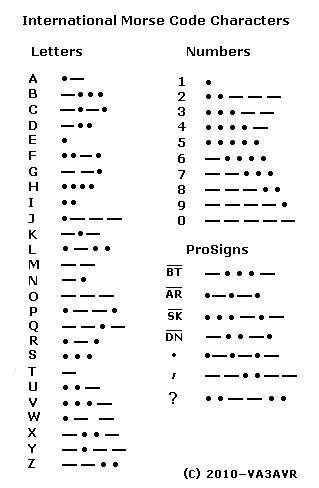
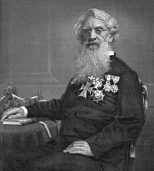 Morse Code
Morse Code 

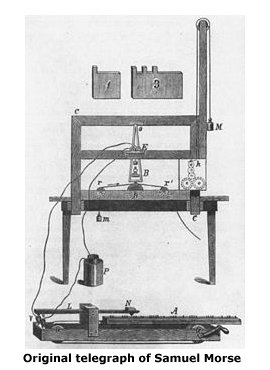 The Alfred Vail/Samuel Morse Controversy:
The Alfred Vail/Samuel Morse Controversy: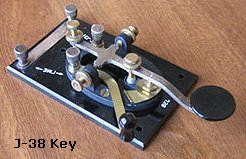 Unfortunately, for a lot of clubs, code is no longer a popular item and used only by those who are experienced users and still use it daily. Or using
a computer keyboard, which is not the same. It is so nice to get your 'Basic 5wpm' added to your call sign and start using the code. A whole new
world will open up you never knew it existed. When that moment comes you will really feel like a real radio amateur, emphasis on 'amateur'. Morse
code can be transmitted by sound or light. Like, banging code on a pipe or wall somewhere, or flashing code with light somewhere in an emergency. It
all works and there are several life saving examples available on the internet. Just 'google' it.
Unfortunately, for a lot of clubs, code is no longer a popular item and used only by those who are experienced users and still use it daily. Or using
a computer keyboard, which is not the same. It is so nice to get your 'Basic 5wpm' added to your call sign and start using the code. A whole new
world will open up you never knew it existed. When that moment comes you will really feel like a real radio amateur, emphasis on 'amateur'. Morse
code can be transmitted by sound or light. Like, banging code on a pipe or wall somewhere, or flashing code with light somewhere in an emergency. It
all works and there are several life saving examples available on the internet. Just 'google' it.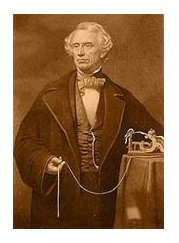

NATO Phonetic Alphabet Alpha Hotel Oscar Victor Bravo India Papa Whiskey Charlie Juliet Quebec X-ray Delta Kilo Romeo Yankee Echo Lima Sierra Zulu Foxtrot Mike Tango Golf November UniformQ-Codes Used For Morse-Code
| Q-Sig | Message |
|---|---|
QRA 
| What is the name of your station? The name of my station is ___. |
QRB 
| How far are you from my station? I am ____ km from you station |
| QRD | Where are you bound and where are you coming from? I am bound ___ from ___. |
| QRG | Will you tell me my exact frequency? Your exact frequency is ___ kHz. |
| QRH | Does my frequency vary? Your frequency varies. |
| QRI | How is the tone of my transmission? The tone of your transmission is ___ (1-Good, 2-Variable, 3-Bad.) |
| QRJ | Are you receiving me badly? I cannot receive you, your signal is too weak. |
| QRK | What is the intelligibility of my signals? The intelligibility of your signals is ___ (1-Bad, 2-Poor, 3-Fair, 4-Good, 5-Excellent.) |
| QRL | Are you busy? I am busy, please do not interfere |
| QRM | Is my transmission being interfered with? Your transmission is being interfered with ___ (1-Nil, 2-Slightly, 3-Moderately, 4-Severly, 5-Extremely.) |
| QRN | Are you troubled by static? I am troubled by static ___ (1-5 as under QRM.) |
| QRO | Shall I increase power? Increase power. |
| QRP | Shall I decrease power? Decrease power. |
| QRQ | Shall I send faster? Send faster (___ WPM.) |
| QRR | Are you ready for automatic operation? I am ready for automatic operation. Send at ___ WPM. |
| QRS | Shall I send more slowly? Send more slowly (___ WPM.) |
| QRT | Shall I stop sending? Stop sending. |
| QRU | Have you anything for me? I have nothing for you. |
| QRV | Are you ready? I am ready. |
| QRW | Shall I inform ___ that you are calling? Please inform ___ that I am calling. |
| QRX | When will you call me again? I will call you again at ___ hours. |
| QRY | What is my turn? Your turn is numbered ___. |
| QRZ | Who is calling me? You are being called by ___. |
| QSA | What is the strength of my signals? The strength of your signals is ___ (1-Scarcely perceptible, 2-Weak, 3-Fairly Good, 4-Good, 5-Very Good.) |
| QSB | Are my signals fading? Your signals are fading. |
| QSD | Is my keying defective? Your keying is defective. |
| QSG | Shall I send ___ messages at a time? Send ___ messages at a time. |
| QSJ | What is the charge to be collected per word to ___ including your international telegraph charge? The charge to be collected per word is ___ including my international telegraph charge. |
| QSK | Can you hear me between you signals and if so can I break in on your transmission? I can hear you between my signals, break in on my transmission. |
| QSL | Can you acknowledge receipt? I am acknowledging receipt. |
| QSM | Shall I repeat the last message which I sent you? Repeat the last message. |
| QSN | Did you hear me on ___ kHz? I did hear you on ___ kHz. |
| QSO | Can you communicate with ___ direct or by relay? I can communicate with ___ direct (or by relay through ___.) |
| QSP | Will you relay to ___? I will relay to ___. |
| QSQ | Have you a doctor on board? (or is ___ on board?) I have a doctor on board (or ___ is on board.) |
| QSU | Shall I send or reply on this frequency? Send a series of Vs on this frequency. |
| QSV | Shall I send a series of Vs on this frequency? Send a series of Vs on this frequency. |
| QSW | Will you send on this frequency? I am going to send on this frequency. |
| QSY | Shall I change to another frequency? Change to another frequency. |
| QSZ | Shall I send each word or group more than once? Send each word or group twice (or ___ times.) |
| QTA | Shall I cancel message number ___? Cancel message number ___. |
| QTB | Do you agree with my counting of words? I do not agree with your counting of words. I will repeat the first letter or digit of each word or group. |
| QTC | How many messages have you to send? I have ___ messages for you. |
| QTE | What is my true bearing from you? Your true bearing from me is ___ degrees. |
| QTG | Will you send two dashes of 10 seconds each followed by your call sign? I am going to send two dashes of 10 seconds each followed by my call sign. |
| QTH | What is your location? My location is ___. |
| QTI | What is your true track? My true track is ___ degrees. |
| QTJ | What is your speed? My speed is ___ km/h. |
| QTL | What is your true heading? My true heading is ___ degrees. |
| QTN | At what time did you depart from ___? I departed from ___ at ___ hours. |
| QTO | Have you left dock (or port)? I have left dock (or port). |
| QTP | Are you going to enter dock (or port)? I am going to enter dock (or port.) |
| QTQ | Can you communicate with my station by means of the International Code of Signals? I am going to communicate with your station by means of the International Code of Signals. |
| QTR | What is the correct time? The time is ___. |
| QTS | Will you send your call sign for ___ minutes so that your frequency can be measured? I will send my call sign for ___ minutes so that my frequency may be measured. |
| QTU | What are the hours during which your station is open? My station is open from ___ hours to ___ hours. |
| QTV | Shall I stand guard for you on the frequency of ___ kHz? Stand guard for me on the frequency of ___ kHz. |
| QTX | Will you keep your station open for further communication with me? I will keep my station open for further communication with you. |
| QUA | Have you news of ___? I have news of ___. |
| QUB | Can you give me information concerning visibility, height of clouds, direction and velocity of ground wind at ___? Here is the information you requested... |
| QUC | What is the number of the last message you received from me? The number of the last message I received from you is ___. |
| QUD | Have you received the urgency signal sent by ___? I have received the urgency signal sent by ___. |
| QUF | Have you received the distress signal sent by ___? I have received the distress signal sent by ___. |
| QUG | Will you be forced to land? I am forced to land immediately. |
| QUH | Will you give me the present barometric pressure? The present barometric pressure is ___ (units). |
Note that Q signals can take the form of a question when followed by a question mark.
Mega Q-Signals A Listing of All Known Q-Signals. Many Apply To Maritime and Aviation Use -- Not for General Ham Use.